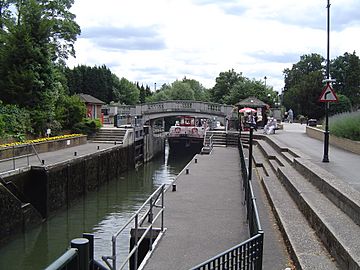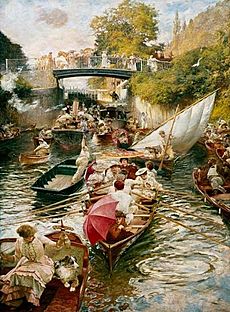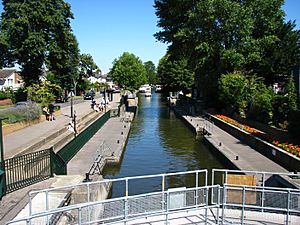Boulter's Lock facts for kids

Boulter's Lock as a pleasure boat squeezes in and under the bridge
|
|
| Waterway | River Thames |
|---|---|
| County | Berkshire |
| Maintained by | Environment Agency |
| Operation | Hydraulic |
| First built | 1772 |
| Latest built | 1912 |
| Length | 60.80 m (199 ft 6 in) |
| Width | 6.47 m (21 ft 3 in) |
| Fall | 2.39 m (7 ft 10 in) |
| Above sea level | 77 feet (23 m) |
| Distance to Teddington Lock |
31 miles (50 km) |
Boulter's Lock is a special kind of gate system, called a lock, and a weir on the River Thames in England. It's located north-east of Maidenhead town centre in Berkshire. The current lock was built in 1912. It replaced older locks that were here since the late 1500s. One of these was built in 1772 by the Thames Navigation Commission. The lock sits on the west side of the river, between the A4094 road and Ray Mill Island. Sometimes, the name Boulter's Lock is also used for the area around it.
The weir is a bit further upstream from the lock. It's at the north end of Ray Mill Island. This spot is very popular for freestyle kayaking. It has been changed so kayakers can use it without bothering other boats on the river.
Contents
History of Boulter's Lock
The first mention of a flash lock here was in the late 1500s. A mill, which grinds grain, was known to be here even earlier, in the 1300s. A flash lock was a simple barrier that could be opened to let boats through. It was located where the main weir is now. There was a winch on the west bank to pull barges through.
In 1746, people said there were no other locks further down the Thames from here. A law passed in 1771, called the Navigation Act, did not allow the Thames Navigation Commission to build locks below Maidenhead Bridge. So, the lock built here in 1772 was the furthest downstream of the first eight locks built by the Commission.
The 1772 lock was made of timber. Joseph Nickalls, who planned river improvements, oversaw its building. It was first on the Taplow side, near Taplow Mill. People called it Boltus lock or Bolters lock. A "bolter" was a miller, referring to the mill nearby. In 1773, a local landowner complained about boat crews causing trouble in his woods. The first lock-keeper's house was built here in 1774. By 1780, the lock was in bad shape. In 1795, a book called Inland Navigation mentioned problems caused by the strong water flow.
Rebuilding the Lock
In 1825, the City of London Corporation suggested rebuilding the lock. They wanted it on the Berkshire side of the river. This meant digging a new channel, about 600-yard (550 m) long. To keep the area dry during building, a waterwheel was put in the weir. This wheel powered pumps. George Gynell got the job to dig the channel for £1,630. Other companies did the stone and mill work. Stone came from Headington Quarry near Oxford.
Because the lock was far from the weir, a 6 hp (4.5 kW) steam engine was used to pump water out of the lock chamber. George Treacher managed the project. Work started in December 1827 and finished in April 1829. The total cost was £11,800. When it was done, this lock was the biggest of its kind with stone walls on English rivers. It was 151 by 19 feet (46.0 by 5.8 m) long, with a water drop of 6 feet (1.8 m). Treacher was given £100 for his good work. The new lock was called Ray Mill pound, after Ray Mill Island. The new channel also created Boulter's Island.
Popularity and Changes
This part of the river became very popular for boating in the late 1800s and early 1900s. A famous painting by Edward John Gregory shows this. The lock was a popular place to visit on the Sunday after Royal Ascot. Wealthy and famous people would pass through on their way to Cliveden. In 1899, an iron fence was put around the lock to keep spectators back. In 1909, the Thames Conservancy bought Ray Mill Island to make the lock bigger. It was rebuilt again in 1912.
Before World War I, the lock often got very crowded. A clever solution was built to help: a moving ramp. This ramp had wooden slats and blocks to stop rowing boats from tipping over. It was like an escalator for boats! Small boats would row onto it and be carried up to the higher water level. The people stayed in their boats. This boat lift opened in 1909 and used an electric motor. We don't know exactly when it stopped working, but you can still visit its old location on Ray Mill Island.
A salmon ladder opened at Boulters Weir on May 19, 2000. It was opened by the Duke of Wellington. This was the last of many salmon ladders built on the Thames. The last salmon caught at this weir before that was in 1923.
Access to Boulter's Lock
The Ray Mead road/Lower Cookham road (A4094) runs next to the lock. There is a public car park about 100 meters north of the lock. A path leads onto the lock island. You can also take an hourly bus from Maidenhead town centre to the lock. This bus is run by Courtney Coaches.
River Above the Lock
After the long channel next to the islands, the river opens up. Here you'll find the start of the Jubilee River on the east bank. Further along are Bavin's Gulls and Cliveden Deep. This area has beautiful beech woods on the hills above. Here sits Cliveden, a large mansion now run by a charity. In the 20th century, it was a meeting place for important people. The river then curves around to Formosa Island and other islands, where Cookham Lock is located.
The Thames Path follows the western (Maidenhead) bank upstream along Cliveden Reach. It then goes into Cookham village, missing Cookham Lock. The path meets the Thames again near Cookham church. In the past, there were ferries to cross the river here.
Kayaking at Boulter's Lock
The weir at Boulter's Lock is a popular spot for kayaking. A canoe/kayak flume is set up here every summer. This flume adds to a permanent ramp in front of one of the weir's six gates.
Boulter's Lock in Books and Media

One of the most famous paintings by artist Edward John Gregory (1850–1909) is called Boulter's Lock, Sunday afternoon.
Nicholas Pocock, a marine artist, lived nearby at 'Ray Lodge'. The famous broadcaster Richard Dimbleby also had a house on Boulter's Island.
The author John O'Farrell grew up in 'The Weir House', which is opposite the lock.
An episode of the TV show Mr. Bean, called Tee Off Mr Bean, was filmed at a miniature golf course next to Boulter's Lock.



